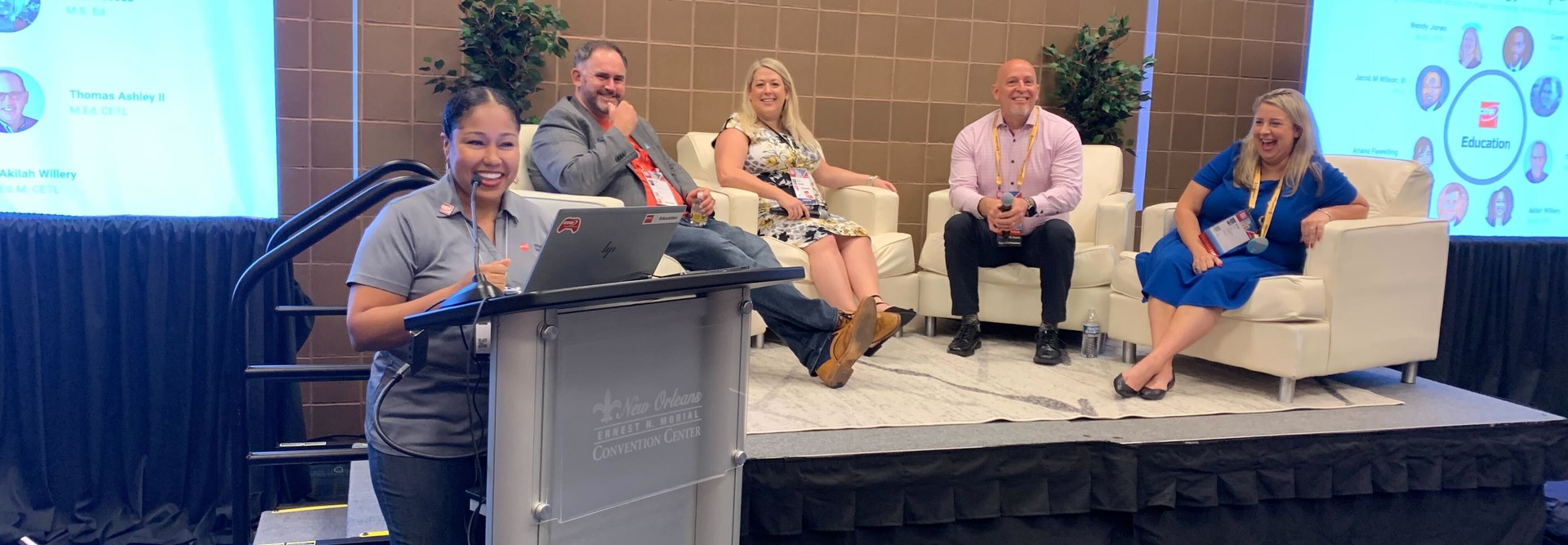A former board president of the International Society for Technology in Education, Bass spoke on the “Powerful Partnerships for EdTech Success” panel on the second day of ISTE’s annual conference, taking place in New Orleans and online. He stressed that one of the biggest benefits of educational technology partnerships is that they further the sustainability of school districts’ tech solutions when funding for them runs out.
“In my world, if we have a rollout, I am responsible for strategizing for it, and I have to make sure that it’s effective and that everything flows together. If things go wrong, I’m going to get the phone call, and I need to be able to have someone to call,” he said.
Bass recalled Chromebook initiatives and other tech investments that his district had secured with grants. Once the funding ran out, there wasn’t a long-term sustainability process in place. Enter the secret ingredient: partnerships.
RELATED: How partnerships drive innovation and success for this k–12 district.
“What partners can do is help you think beyond this pile of money that you just got and consider: How are you going to do this in three years? How are you going to do this in five years?” Bass said. “Once you introduce something like that, you better not take it away. That’s where partners are effective and help to create a successful project.”
This was one of many examples that underscored the value of educational technology partnerships to help educators maintain their momentum in advancing students’ learning experiences and opportunities.
Hosted by CDW•G and moderated by CDW education strategist Akilah Willery, the conversation highlighted how the company is poised to make vital connections and collaborations to meet the needs of educational technology leaders, educators and IT decision-makers.
“As a teacher, we’ve pretty much accomplished the impossible. We never want to have to go back to level 0. We’re probably at level 47, and we want to be able to build and launch to whatever that next great level is going to be,” said Willery, who was a teacher for 23 years before joining CDW•G.
Extending Value Beyond Schools and into Communities
CDW’s Toni Hargis has spent the past seven years as an area sales director for the Central U.S. She said the work has been meaningful because of CDW’s ability to leverage its scale and the scope of its partnerships to bring value back to customers. As you might expect, the pandemic created some particularly daunting challenges.
Hargis talked about helping to roll out hundreds of thousands of technology devices to schools in her region during a short period of time.
“And not just to deliver them; there was so much more that had to go on,” she said. “We had to order them at the height of the COVID supply chain issues. We had to partner with a lot of different suppliers to make sure that the inventory was going to be able to come in. That was just really the first step. How we were going to be able to get them to the students was where the real work began.”
DIVE DEEPER: Districts partner with businesses to train tomorrow’s IT workforce.
Hargis detailed other hurdles including configuring the devices and ensuring that the right long-term help desk support and warranty support were in place.
“We all know that when you give a device to children, there’s a good chance that it’s going to get broken, even with a case on it. How are we going to manage through all of that?” she said. “We were able to establish a facility in Jackson, Miss., which will be the hub of all of this work, not just for us to do the deployment, but for the long-term management of everything for Mississippi K–12 schools. It brought a lot of money back to the local community so they are able to create jobs and increase wages and investment in the community. For us, having the opportunity to be able to give back in that way really takes it to the next level in terms of what we do for education.”
Broadening the Horizons of Innovation
Ed tech partnerships also create opportunities for forward-thinking educational technologists who might not have buy-in from their districts or like-minded partners and collaborators to explore possible technology solutions and ideas.
“Being an innovator in your district can be really lonely. If you’re the innovator in your district doing this work, sometimes it can feel a bit Sisyphean, where you’re pushing the boulder up the hill and then it rolls back on you a little bit,” said Erin Mote, executive director of InnovateEDU and co-founder of Brooklyn Laboratory Charter School. “Being able to say, ‘I need help with this’ and having a partner that you’re comfortable asking those questions of makes the difference. As long as we’re focusing on serving kids, there are a lot of people who have your back.”
Other key areas for partnership include working with school districts and IT staff to identify and solve problems, understanding what districts are trying to achieve and determining which educational technology tools can help them accomplish their goals, said Tim Lee, founder and vice president of Amplified IT, a CDW company.
LEARN MORE: School districts turn to outside experts to beef up their cybersecurity posture.
“Also, how can we build communities? We want to work our partnerships to bring together communities of IT directors and groups to share best practices for Google Education,” Lee said. “Last year, we were acquired by CDW, and one of the really cool things now is that we’re able to look at that wider space. Now we can expand out to different educational technologies.”
Lee also said that he and his Amplified IT team are excited about being part of CDW Education’s efforts to build out services and focus on what schools are trying to achieve.
“The innovation across this conference is also happening every day across schools. We need to raise that up and showcase that,” he said. “That’s where partnerships can come in, where we’re able to scale to thousands of schools.”
Keep up with EdTech: Focus on K–12’s coverage on our ISTELive page and via Twitter with the hashtag #ISTELive.











